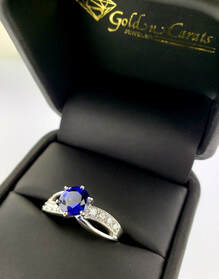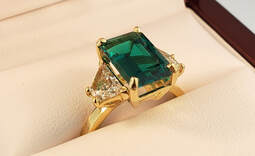|
There can be so many terms to describe colored gemstones - what do they all mean and why is it important? Below, we get you the answers you're looking for! Note that here we are talking about colored gemstones. Diamonds are typically separated in how we talk about them - we will have an article up about diamonds later! Natural Gemstones This one is pretty simple - a natural gemstone is a mined-from-the-ground stone that has an underlying chemical makeup and crystal structure normal of that specifically named stone. It was not made in a lab! For most stones that we can mine & find in the earth, there are now synthetics & imitations for those stones. Now, a natural gemstone does not mean that it has not been altered or treated in any way once it came out of the ground. Actually, a vast majority have been treated in some way (irradiation, heat, pressure, oil, etc.) to either bring out the best color, stabilize it, or reduce the visible inclusions. For example, nearly ALL natural Tanzanite stones (still only mined in Tanzania) are treated after they come out of the mine - the rich bluish purple that so many desire often begins as a brown stone! What is the benefit of a natural gemstone? The value and the rarity are the biggest factors that make a natural stone preferable over a synthetic or an imitation. Also, know who you are gifting a piece of jewelry to - would they prefer a natural stone? Not many stores will purchase a synthetic gemstone to resell, either. Synthetic Gemstones Repeat after me: Synthetic and Imitation gemstones are NOT the same! Synthetic gemstones have been around since the 1800's when a chemist in France first started with synthetic rubies (corundum) and created one of the processes called flame fusion which is still in use today. Interestingly enough, though he had discovered and reported on the process in 1891 to a university in France, he did not go public with the news until 1902 - we have to wonder, what happened in that 11 years? Synthetic gemstones are based on the real thing - the same chemical and crystalline structure that is found in the natural stone. Synthetics are typically made to imitate the cleanest (inclusion wise) and most desirably colored version of the natural stone. Not all synthetics are the same! Many different companies make synthetic gemstones. What is held as arguably the best and most well-known of the synthetic labs is Chatham, who has been around since 1938. Common gemstones that are available as a synthetic stone (not an exhaustive list):
But why make a synthetic? Or why not?  Usually a synthetic is produced if the natural gemstone is valuable enough for the market to benefit from a less expensive option (sapphires), or if many options are not high quality (emeralds) or not easily found (alexandrite). Some stones are not available (or very rare) in synthetic options, for various reasons. Some of those stones include:
We have been able to offer great options to our customers over the years through the use of synthetic stones. Recently, we have made engagement rings using a gorgeous synthetic sapphire (pictured above) and a custom-cut synthetic emerald from Chatham (also pictured). Something else you might not know: both Cubic Zirconia and Moissanites are lab-created stones, not imitations! Though they do not have natural, mined-from-the-ground counterparts, we do have the basic understanding of their crystalline structure and have their chemical make up to make them in a lab! Though sometimes these are called "synthetic diamonds," this is an absolutely INCORRECT term as they are not made up of the same crystalline structure and chemical makeup as a diamond. Ask us our thoughts next time you are in! We'd love to help you take on a new, fun, colorful project. Imitation GemstonesImitation gemstones are merely that: something to imitate or mimic the LOOK (not the crystal structure or chemical makeup) of a natural stone.
What are they made of? Plastic, glass, some are even a less well made synthetic, or a synthetic of another type of stone that looks "similar enough." Some are painted or coated on the bottom (or the whole thing) to change the sheen or the color. These options typically do not wear as well (are not as strong) as the natural or synthetic options, but they are extremely inexpensive. We do not suggest them for projects we work on unless it is repairing costume jewelry, though there are some cases where an imitation does come into play. Have more questions? Contact us at [email protected]!
0 Comments
Leave a Reply. |
AuthorAssistant Manager Jenna Rogers gets the answers from our jeweler to your most important jewelry questions! Archives
February 2021
Categories |
Christmas HoursMon-Fri: 10am - 6pm
Sat: 10am - 5pm |
Phone(972) 910-0300
Call or Text |
|
Address
7750 N MacArthur Blvd #100, Irving TX 75063
|

 RSS Feed
RSS Feed



